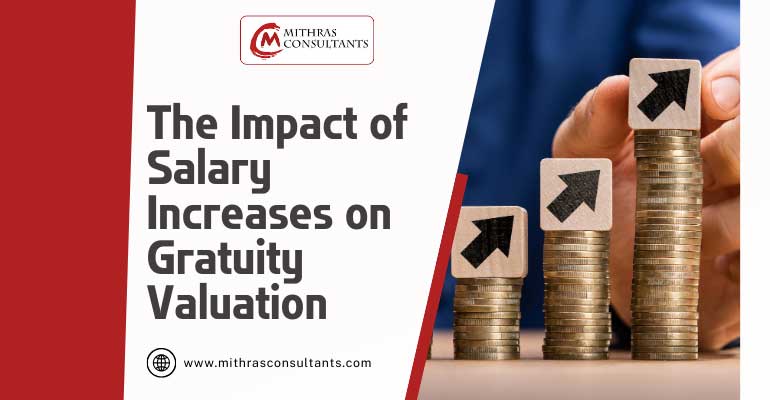The Impact of Salary Increases on Gratuity Valuation

Gratuity is a vital part of employee benefits in India. It offers a financial cushion to employees after long years of service. Employers must understand the impact of salary increases on gratuity valuation to manage their liabilities effectively.
What Is Gratuity and How Is It Calculated?
Gratuity is a lump sum payment made by an employer to an employee upon retirement, resignation, death, or disability. In India, it is governed by the Payment of Gratuity Act, 1972. An employee becomes eligible for gratuity after completing five years of continuous service.
The basic formula used is:
Gratuity = (15 / 26) × Last Drawn Salary × Number of Years of Service
Here, the last drawn salary includes the basic salary and dearness allowance (DA). The fraction 15/26 represents 15 days’ wages for every completed year of service, assuming a 6-day working week.
Salary Hikes and Their Direct Effect on Gratuity
When an employee receives a salary increase, it affects the gratuity amount significantly. Since gratuity is calculated based on the last drawn salary, even a small increase in basic pay and DA results in a higher liability for the employer.
Let’s take an example:
- Employee A has 20 years of service.
- Previous basic salary = ₹30,000
- Revised basic salary after increment = ₹35,000
Before increment: Gratuity = (15 / 26) × 30,000 × 20 = ₹3,46,154
After increment: Gratuity = (15 / 26) × 35,000 × 20 = ₹4,03,846
Here, a ₹5,000 hike led to an increased gratuity liability of nearly ₹57,692.
Future Salary Projections and Actuarial Valuation
In accounting, companies need to estimate gratuity liability as of a given balance sheet date. Actuarial valuation methods are used to calculate this liability based on several assumptions, including:
- Future salary growth
- Employee attrition rates
- Retirement age
- Mortality and disability rates
The assumption of future salary escalation is a key component in these valuations. A higher expected salary growth rate leads to a higher present value of gratuity obligations.
For example, if a company assumes a 7% annual salary growth instead of 5%, the projected gratuity liability increases considerably. This increase affects the company’s financial reporting and provisioning.
Role of Basic Salary Structure in Gratuity Cost
Employers must pay close attention to how they structure salaries. Since gratuity is based on basic salary and DA, companies that keep a higher basic component will see a greater impact when salaries increase.
For instance:
- Company A gives a 40% basic salary component
- Company B gives only a 25% basic salary component
An increment of 10% in both cases would result in a higher increase in gratuity liability for Company A due to the bigger base salary used in gratuity calculations.
Thus, the composition of the salary plays a crucial role in understanding and managing gratuity-related costs.
Strategic Workforce Planning and Financial Implications
The impact of salary increases on gratuity valuation also affects strategic workforce planning. Employers must consider the following:
- When to give increments (timing can influence year-end liability)
- Which employees are nearing retirement (as their gratuity is paid soon)
- Attrition patterns and retention strategies
From a financial perspective, sudden and unplanned salary hikes can lead to under-provisioning. This can adversely impact a company’s financial statements, especially during audits.
Proper planning helps avoid surprises in liability recognition and ensures compliance with Ind AS 19 / AS 15 accounting standards.
Gratuity Funding and Investment Considerations
To manage gratuity payouts, many companies set up gratuity funds with approved trusts or insurers. These funds need to be managed wisely.
A salary hike affects the required contribution to the gratuity fund. Employers need to:
- Reassess funding levels after increments
- Adjust future contributions accordingly
- Align investment strategies with rising liabilities
Timely valuation and proactive funding help mitigate future financial stress due to gratuity payments.
Importance of Periodic Gratuity Valuation
Given that salary increases impact gratuity valuation, companies must conduct periodic actuarial valuations. Ideally, a valuation should be done:
- At the end of each financial year
- After significant workforce or salary changes
- When planning a merger, acquisition, or restructuring
Frequent valuations help maintain accurate records, ensure compliance, and give better insights for HR and finance departments.
Key Takeaways
- Gratuity is calculated on the last drawn salary, so any hike increases the payable amount.
- Higher salary growth assumptions inflate actuarial liability.
- A salary hike close to retirement can significantly raise the gratuity payout.
- Salary structure (especially basic + DA) directly impacts gratuity costs.
- Periodic actuarial valuation ensures accurate provisioning and planning.
Conclusion
Salary increments bring positive motivation to employees but also increase financial obligations for the employer. Employers must evaluate how such changes affect long-term benefits like gratuity. With rising salary structures and increasing employee retention efforts, gratuity valuation becomes a critical part of financial planning.
To manage this efficiently, expert actuarial support becomes essential.
Mithras Consultants is an independent actuarial and insurance consultancy firm providing qualitative financial and insurance solutions to its clients. Our goal is to provide business solutions customised to client’s needs to help our clients make the best possible decisions on their financial, insurance and risk management programs.

 Call Us
Call Us Whatsapp Us
Whatsapp Us